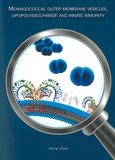Meningococcal outer membrane vesicles, lipopolysaccharide and innate immunity

Zariri, Afshin
- Promoter:
- Prof.dr. J.P.M. (Jos) van Putten
- Co-promoter:
- Dr. P. (Peter) van der Ley
- Research group:
- Putten
- Date:
- March 31, 2016
- Time:
- 10:30 h
Summary
Adjuvants are molecules that increase the immunogenicity of an antigen and play a key role in initiating an immune response. Traditional whole cell or outer membrane vesicle (OMV) vaccines already have components that are recognized by pattern recognition receptors (PRRs) on immune cells. On the other hand, increasing knowledge and implementation of new techniques has increased the application of highly purified recombinant proteins and single antigens as vaccines. Although much safer, these single antigen vaccines lack efficient immune stimulants, necessitating separate addition of adjuvants. Lipopolysaccharide (LPS), a dominant component of the Gram-negative bacterial outer membrane, can be a strong activator of the innate immune system and is the basis for novel adjuvants. Neisseria meningitidis, a Gram-negative diplococcus, which has humans as only reservoir of infection, can cause bacterial meningitis and sepsis. Although meningococcal LPS is a potent activator of the PRRs TLR4 and MD-2, in its wild type form it would be too toxic for use in humans. Thus for application as adjuvant, either as internal component of whole cell or OMV vaccines or as addition to purified antigens, modulation of its activity is desirable. We have performed modifications to the basic LPS structure, both by deletion of LPS biosynthesis enzymes and heterologous expression of LPS modification enzymes. This provided us with an array of LPS derivatives with a broad range of TLR4/MD-2 stimulating capabilities and differential cytokine induction. Using these LPS derivatives on cells expressing TLR4/MD-2 from different species we found that changes to the LPS structure can have quite different effects in different species. Thus, extrapolation from animal models when testing LPS molecules must be done with caution. Due to the fact that N. meningitidis is an exclusively human pathogen, many of the host-pathogen molecular interactions are specific for receptors on human cells. For example, the meningococcal opacity (Opa) proteins, which bind to the carcinoembryonic antigen-related cell adhesion molecule (CEACAM) family of receptors thereby aiding attachment and invasion by the bacterium, do so exclusively to the human versions. Because binding of Opa proteins to CEACAM1 was shown to suppress T cell proliferation in vitro, using animal models may not give an accurate picture of their effects on immunogenicity in Opa-containing OMV vaccines. We have immunized transgenic mice expressing human CEACAM1 with OMVs and found that the Opa-specific immune response is lowered in the presence of human CEACAM1 in vivo. Others found similar effects for the other neisserial proteins factor H binding protein, transferrin binding protein B and Neisseria surface protein A in transgenic mice expressing their cognate receptors, indicating a more general effect of reduced immunogenicity with protein antigens that can bind to their receptor.